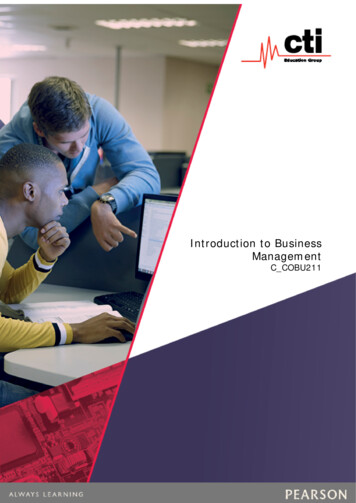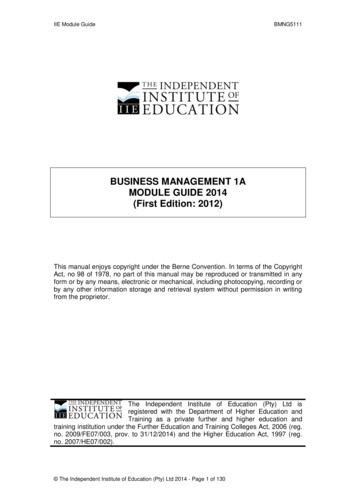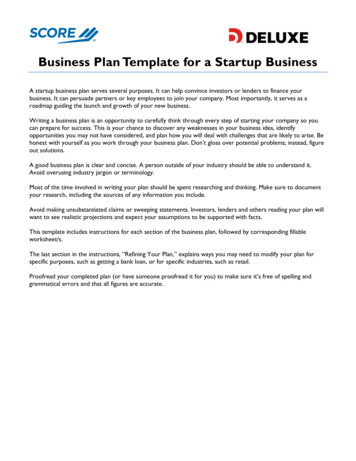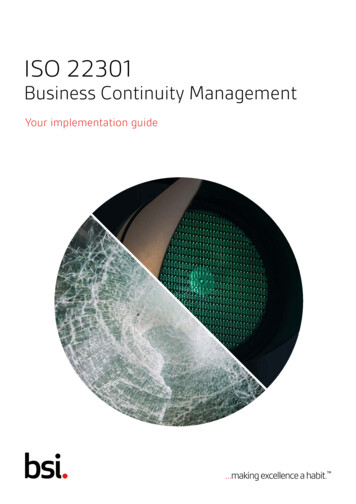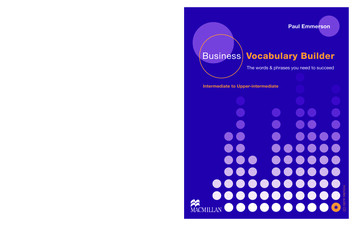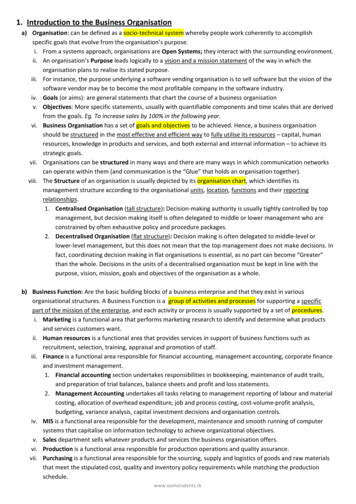
Transcription
1. Introduction to the Business Organisationa) Organisation: can be defined as a socio‐technical system whereby people work coherently to accomplishspecific goals that evolve from the organisation’s purpose.i. From a systems approach, organisations are Open Systems; they interact with the surrounding environment.ii. An organisation’s Purpose leads logically to a vision and a mission statement of the way in which theorganisation plans to realise its stated purpose.iii. For instance, the purpose underlying a software vending organisation is to sell software but the vision of thesoftware vendor may be to become the most profitable company in the software industry.iv. Goals (or aims): are general statements that chart the course of a business organisationv. Objectives: More specific statements, usually with quantifiable components and time scales that are derivedfrom the goals. Eg. To increase sales by 100% in the following year.vi. Business Organisation has a set of goals and objectives to be achieved. Hence, a business organisationshould be structured in the most effective and efficient way to fully utilise its resources – capital, humanresources, knowledge in products and services, and both external and internal information – to achieve itsstrategic goals.vii. Organisations can be structured in many ways and there are many ways in which communication networkscan operate within them (and communication is the “Glue” that holds an organisation together).viii. The Structure of an organisation is usually depicted by its organisation chart, which identifies itsmanagement structure according to the organisational units, location, functions and their reportingrelationships.1. Centralised Organisation (tall structure): Decision‐making authority is usually tightly controlled by topmanagement, but decision making itself is often delegated to middle or lower management who areconstrained by often exhaustive policy and procedure packages.2. Decentralised Organisation (flat structure): Decision making is often delegated to middle‐level orlower‐level management, but this does not mean that the top management does not make decisions. Infact, coordinating decision making in flat organisations is essential, as no part can become “Greater”than the whole. Decisions in the units of a decentralised organisation must be kept in line with thepurpose, vision, mission, goals and objectives of the organisation as a whole.b) Business Function: Are the basic building blocks of a business enterprise and that they exist in variousorganisational structures. A Business Function is a group of activities and processes for supporting a specificpart of the mission of the enterprise, and each activity or process is usually supported by a set of procedures.i. Marketing is a functional area that performs marketing research to identify and determine what productsand services customers want.ii. Human resources is a functional area that provides services in support of business functions such asrecruitment, selection, training, appraisal and promotion of staff.iii. Finance is a functional area responsible for financial accounting, management accounting, corporate financeand investment management.1. Financial accounting section undertakes responsibilities in bookkeeping, maintenance of audit trails,and preparation of trial balances, balance sheets and profit and loss statements.2. Management Accounting undertakes all tasks relating to management reporting of labour and materialcosting, allocation of overhead expenditure, job and process costing, cost‐volume‐profit analysis,budgeting, variance analysis, capital investment decisions and organisation controls.iv. MIS is a functional area responsible for the development, maintenance and smooth running of computersystems that capitalise on information technology to achieve organizational objectives.v. Sales department sells whatever products and services the business organisation offers.vi. Production is a functional area responsible for production operations and quality assurance.vii. Purchasing is a functional area responsible for the sourcing, supply and logistics of goods and raw materialsthat meet the stipulated cost, quality and inventory policy requirements while matching the productionschedule.www.oumstudents.tk
c) Management Process & Business Process Re‐Engineering:i. Management Process: Procedures that make up the basic duties of a business manager. There are four basicmanagement process, namely,1. Planning: The decision of who is going to do what by when, or what is going to be done when by whom,depending on whether the management style is process‐oriented or product‐oriented. The resultingbusiness plan (or a draft) should include:a. Plan objectives;b. Core activities (tasks) and procedures;c. Initiatives and requirements; andd. Key performance indicators and appraisal methods.2. Organising: Organising is deciding what task is to be achieved by when. This process includes obtainingnecessary resources like finance and equipment, and organising and scheduling each facet of the plan.It is usually required to break tasks into smaller units (the sub‐tasks) and allocate sub‐tasks to capableindividuals with definite completion dates.3. Directing: Following the organising stage, the activities of the plan are carried out in the directingstage. The managers implement or execute the plan as it was organised, and resources and personnelare deployed according to the pre‐determined time sequence. The process leader (who may not be thefunctional manager) leads, motivates, delegates and coordinates in order to complete the process.4. Controlling: The process of setting a standard, measuring the actual performance, and reviewing thevariance, which is the difference between the actual and the standard. If the variance is beyond thepre‐defined tolerance level, some adjustments or remedial actions must be arranged. The standardcould be a capital budget, sales volume or defect level.ii. Business Process: A set of logically related tasks performed to achieve a defined business outcome. We canidentify business processes in an organisation by using Value Chain Model. BP has two characteristics:1. It has customers (internal or external); and2. It crosses functional boundaries (it communicates between functions through its inputs and outputs).d) Business Mission & Vision:i. Purpose: a reason for being. Every organisation has a purpose.ii. Mission: in an organisation can be viewed as how it will achieve its purpose or an overall statement of itsbusiness direction. A mission is a broad “Philosophical” statement that ties an organisation to certainactivities and to economic, social, ethical or political ends. Eg. “To be the World’s Number One Airline.”1. Business Strategy Model of Mission: is a strategic tool that defines the business’ commercial rationaleand target market.2. Philosophy & Ethics Model of Mission: the cultural “Glue” enabling an organisation to function as acollective unit. This cultural glue includes strong norms and values that influence the way in whichpeople behave, how they work together and how they pursue the goals of the organisation3. Holistic Model of Mission: Has four elementsa. Purpose: Addresses why an organisation exists. For whosebenefit is all this effort being put in?b. Strategy: Provides the commercial logic for the organisation.c. Behaviour Standards: Thus, behaviour standards are the normsand rules of “The way we do things around here”d. Values: Beliefs and moral principles that lie behind theHolistic Modelbehaviour standards or the organisation’s culture.iii. Vision: Required when an organisation wants to change itself in some radical way. A vision statementdescribes the image of an organisation’s possible and desirable future state. It represents a view of arealistic, credible, attractive future for the organisation – a condition that is better in some important waysthan what exists at present. Vision refers to a future state while mission normally refers to the present.www.oumstudents.tk
e) Business Objectives and Goals:i. Objectives: Are precise, well‐specified targets that are measureable and a business enterprise intends toachieve them by a given time. One target (goal) may give rise to several objectives. Eg. “Increase sales by40% per year”ii. Goals: Are general statements about the direction in which a business enterprise intends to go, withoutstating specific targets to be reached by particular times. Mission of an enterprise is the highest levelstatement of goals (and objectives). Eg. A vague statement such as “Be a market leader”1. Long‐term goals: relate to extended periods, usually five years or more into the future.2. Intermediate goals deal with one to five years.3. Short‐term goals: (likely objectives) deal with period of less than or up to a year.2. Strategic Planninga) Planning: An analytical process which involves an assessment of the future, the determination of desired goalsand objectives in the context of that future, the development of alternative courses of action to achieve suchobjectives and the selection of courses of action among those alternatives.b) Strategy: The determination of the basic long‐term goals of an enterprise and the adoption of courses ofactions and the allocation of resources necessary to achieve these goals. It is presented as policies whereby theorganisation elaborates its goals and objectives.i. Corporate strategy is concerned with what businesses a corporation does and does not, wish to enter.ii. Business strategy is concerned with achieving the goals of a particular business within a corporation. It is thedetermination of how a company will compete in a given business and position itself among its competitors.iii. Functional strategies deal with major aspects of the business’ functional operations: marketing, production,finance, human resources and research and development (R&D).c) Policy: An elaboration of strategy so as to apply effectively internal resources and thereby achieve strategicobjectives and goals. While policy is a guide to action, strategy is the action itself.d) Strategic Planning: The process of planning the future strategy of an organisation and documenting thestrategy in an implementation plan.i. Effective strategic planning deals with two relevant dimensions:1. Responding to changes in the external environment and2. Creatively deploying internal resources to improve the competitive position of the enterprise.ii. Advantages of Strategic Planning (Benefits of, Needs for Strategic Planning):1. It is a communication process and so improves the coordination in every organisation practising it2. It motivates managers.3. It leads to better organisational decisions.4. It provides a way of controlling a business.iii. Strategic Plan: This document is the outcome of the strategy planning process. A mechanism for putting intoeffect strategic decisions. Reflects the contingencies of the business as defined by realistic businessscenarios and is articulated by senior management. Four components:1. A definition of the desired future scope of the organisation, including a statement of its business andwhat kind of company it is and it should be.2. A definition of the competitive advantage of the company, including its distinctive competence inrelation to its competitors and the market niche it intends to occupy.3. A statement of mission, goals and objectives and the measures to evaluate performance.4. A statement of how resources that are needed to implement and execute the plan will be allocated.iv. Strategic Planning Process analyses and determines where the organisation intends to be in the long term,usually three or more years in the future. Three key tasks:1. Identify a distinctive competence (something the organisation do really well) for the organisation.2. Find a niche (social and economic situation org is well suited) in the organisation’s environment.3. Find the best match between the organisation’s distinctive competencies and its available niches.www.oumstudents.tk
v. SWOT Analysis: (Strength, Weakness, Opportunities, Threats)Popular Method of business strategy planning. It has four steps:1. Setting Strategic Goals (long‐term goals derived directly fromorg’s mission statement)2. Environmental Analysis: Involves scanning the environment forthreats and opportunities. BCG Matrix and Industry Attractiveness‐Process of SWOT AnalysisBusiness Strength Matrix can be used here.3. Organisational Analysis: to better understand their own company’s strengths and weaknesses.4. Formulating Business Strategya. Business Strategy consists of a set of well‐coordinated action programmes and policies aimed atsecuring a long‐term sustainable competitive advantage. These programmes are defined at twodifferent levels of specificity:b. Formulation of business strategy is accomplished by matching environmental threats andopportunities with organisational strengths and weaknesses. Most important part.( Cash Use‐up )vi. Strategic Planning Tools: There are two:1. Boston Consulting Group (BCG) Matrix: a tool based onbusiness portfolio analysis.a. Assume that there is a company with multipleproduct lines. Such companies have products atvirtually every point in the product life cycle. Forexample, the management of a firm may use theBCG matrix to evaluate the market growth rate andrelative market shares for each of their products.b. There are three basic insights from the BCG matrix:( Cash Generation )i. The graphical matrix representation provides apowerful and compact visualisation of the strengths of the firm’s portfolio of businesses, or awhole business.ii. It helps identify the ability for cash generation as well as the needs of cash for each business.iii. Because of the distinct quality of each business, it can suggest unique strategic directions.2. Porters Competitive Strategy Framework (Porters 5 ForcesModel): in the fight for market share, competition does notcome only from the other players. Rather, competition in anindustry is rooted in the underlying economics andcompetitive forces exerted from beyond the establishedcombatants in a particular industry.a. McFarlan proposed five questions for assessing thestrategic impact of IT on a firm: If the answer to a particularPorters Five Forces Modelquestion is “Yes,” a strategic opportunity exists that requires the attention of top management.i. Threat of new entrants: Can IT be used to build barriers against new entrants?ii. Customers: Can IT be used to build switching costs (increase customer reliance on systems)?iii. Competitors: Can IT change the basis of competition?iv. Suppliers: Can IT change the balance of power in supplier relationships?v. Substitutes: Can IT be used to generate new products?b. Porter shows three potentially successful generic approaches for competing:i. Cost leadership: A firm has many avenues for pursuing this strategy, including economies ofscale, using or developing new technology and developing preferential access to rawmaterials. Where competition has been sluggish, becoming a cost leader may revolutionisethe entire businesswww.oumstudents.tk
ii. Differentiation: Requires the organisation to seek uniqueness in the eyes of the customers,which justifies their paying a premium price for the product.iii. Focus: or niche strategy requires a narrow competitive scope. The organisation focuses on asmall target group and services this group or segment to the exclusion of others.3. Strategic Use of Information Technologya) Strategic Information Systems (SIS): enable a firm to gain a competitive edge or to undermine its rival’sadvantages.b) Information System & Information Technology:i. Information System (IS): can be defined as a set of procedures that collects or retrieves, processes, storesand disseminates information to support organisational decision making and control.ii. Information Technology (IT): can be defined as a powerful collection of elements which include computerhardware, software, telecommunication networks and related technologies.c) IS & IT Strategy:i. IS strategy refers to what an organisation should do with the technology; andii. IT strategy: how they do it.d) Evolution of Information Systems: Can be seen in four eras, which are:i. Centralised Era (Data Processing Era): This era is dominated by information systems that function primarilyas the processing of predefined (business) transactions to produce fixed‐format reports on schedule.1. Technologically speaking, the era is marked by the development of Direct Access Storage Devices(DASD) and Database Management Systems (DBMS), and Management Information Systems (MIS).2. But these systems, apart from processing the transaction data, did not meet the information needs ofmanagers and professionals as organisations began to flatten and globalisation began to take shape inthe late 1970s.ii. Decentralised Era: It was the emergence of personal computers and low‐cost software around 1980 thatopened the era of decentralisation.1. People with abundant supplies of user‐friendly software tools found themselves able to developapplications (small information systems) for their own use even without the leadership of skilfultechnicians or formal methodologies for software development.2. The control of development and application was decentralised to individual managers who were able tosolve their ad hoc problems by building simple but useful software solutions with little effort on theirPCs or mainframes.3. Decision Support Systems (DSS): These systems were not simply to provide higher quality informationfrom the use of decision models and databases; rather, they were meant to improve the quality of themanagerial decision process itself.4. Executive Information Systems (EIS): Systems that were specifically designed for top management.iii. Architecture Era: The continued proliferation of PC and communications technologies, including the Internettechnology in the period of 1985 to 1996, offered corporations a chance to re‐adjust the role played by IT.1. In the early years of this era, SIS might have just been a Management Information System (MIS).2. It was distinguished from the other MIS in the way that it directly supported or shaped the competitivestrategy of the organisation.3. With the introduction of Business Process Re‐engineering (BPR), management started to realise thatsimply focusing on the strategic advantages brought about by an MIS was not sufficient.iv. Internet Era: The Internet arrived long before 1997, which is the beginning of the Internet era. However, itdidn’t receive as much attention as it does today when every organisation (business, government orotherwise) tries to get the benefit out of the Internet.www.oumstudents.tk
e) IT as a Strategic Resource: The emerging new role of IT within organisations is the result of two concurrent andperhaps equally powerful forces:i. Technology push: force has emerged partly due to significant improvement in the price‐performance ratioof IT and partly due to increased connectivity capabilities over time.ii. Competitive pull: has emerged because markets are becoming highly competitive and the traditionalsources of competitive advantages are diminishing as competitors strive to attain parity with one another.f)IT & Competitive Strategy: IT exerts a strong influence on organisations.i. It changes the way work is done, whether it is production, coordination or managerial work.ii. It integrates business functions at all levels and gives rise to organisational teams, electronic alliances andelectronic markets.iii. It permits a high degree of simultaneous collaboration and competition in the industry.iv. It presents new strategic opportunities and changes organisational structure.v. It, therefore, poses a major challenge for management today to catalyse the necessary transformation oftheir organisation.g) Competitive Advantage & Competitive Necessity:i. Competitive Advantage: To gain competitive advantage or beat the other competitors.ii. Competitive Necessity: To stay in the business or maintain competitioniii. Sustainable Advantage: One competitive advantage that makes its possessor immune from attack bycompetitors attempting to duplicate, emulate or copy ith) Risks of Using IT Strategically: Even though IT can provide competitive advantage when it is appropriatelyapplied, it can also cause disasters when it is misapplied, neglected or ignored. Some are:i. Its failure to meet real customer needs,ii. Its failure to be defensible,iii. It may wake a sleeping giant,iv. It may trigger litigation or regulation, andv. It may be rejected by customer or organisational culture.i)Inter‐Organisational System (IOS): A special type of communication‐intensive information system whosedevelopment, operation and use are shared by two or more organisations. These organisations may be part of acooperative (like a banking network) or may be in a customer‐supplier relationship.i. IOS has eight characteristics:1. They require “Partners.” Thus, at least two parties are needed to create an IOS.2. Standards have a major role in IOS development3. Education of potential “Partners” is very important to overcome ignorance and political issues.4. Third parties are often required, either to educate people; or to develop and maintain the standards; oroften to provide links between the separate systems of the partners.5. Work must be synchronised, otherwise these systems cannot be maintained or upgraded.6. Work procedures need re‐evaluation after IOS is in use. As IOS may change the way business is done.7. Technology is not a major hurdle compared to the relationship issues.8. IOS development requires more openness, especially when industry standards are being employed.ii. Technological, economic and organisational changes leading to growth of IOSs:1. Need for fast, reliable information exchange in response to rapid changing markets, products & services2. Evolution of guidelines, standards and protocols.3. Penetration of IT into internal business processes.4. Technical quality and capability of IT.5. Use of IT to distinguish product and/or organisation.www.oumstudents.tk
j)Information Partnerships: Through such a partnership, diverse companies can offer novel incentives andservices or participate in joint marketing programmes. They can make small companies look, feel and act big,reaching for customers once beyond their grasp.k) IOS and Competitive Advantage: The proliferation of IOS suggests that many organisations are finding it to bean important source of competitive advantage. The competitive advantage stems fundamentally from twofactors:i. Comparative efficiency: Allows an organisation to produce its products or services more cheaply than itscompetitors; andii. Bargaining power: Allows a firm to resolve bargaining situations with its customers and suppliers to its ownadvantage.l)Strategic Grid: Identifies the role of IT in an organisation. Help to position an organisation appropriatelyi. At the beginning of an analysis, specific IT applications or business units are positioned within differentquadrants on the strategic grid.ii. The axis Operational Dependence mean to measure the negative consequence resulted as a failure of anexisting IT application; while we mean to measure the competitive advantages or new opportunities createdif a new IT system is developed.iii. Strategic grid can also be used to evaluate IT portfolios and IT development plans. IT applications in each ofthe four quadrants bear certain specific characteristics.iv. The four Quadrants:1. Strategic: These systems are designed to make the businessstand out from its competitors. Eg. banking business2. Factory: These systems are what an organisation is relying on inits daily operation of business and customer services. Eg. miningindustry3. Support: They are usually systems that handle routine administrativeMcFarlan‐McKenny's Strategy Gridtasks such as accounting and personnel. Eg. paper manufacturing4. Turnaround: These are usually implementations of new concepts,perhaps resulting from a R&D proposal. Eg retailingm) Value Chain Analysis (Value Added Model): A systematic way of analysing andevaluating the process of creating goods or services. A generic model forbusiness activity analysis. There are two classes of activities:Porters Value Chain Analysisi. Primary Activities:1. Inbound logistics include the receiving, warehousing, and inventory control of input materials.2. Operations are the value‐creating activities that transform the inputs into the final product.3. Outbound logistics are the activities required to get the finished product to the customer, includingwarehousing, order fulfillment, etc.4. Marketing & Sales are those activities associated with getting buyers to purchase the product, includingchannel selection, advertising, pricing, etc.5. Service activities are those that maintain and enhance the product's value including customer support,repair services, etc.ii. Support Activities:1. Procurement ‐ purchasing the raw materials and other inputs used in the value‐creating activities.2. Technology Development ‐ includes research and development, process automation, and othertechnology development used to support the value‐chain activities.3. Human Resource Management ‐ the activities associated with recruiting, development, andcompensation of employees.4. Firm Infrastructure ‐ includes activities such as finance, legal, quality management, etc.www.oumstudents.tk
n) Customer Resource Life Cycle: can be used to identify and implement SIS by focusing on how to help customersacquire and use a product or service. The customer resource life cycle model provides a much more detailedanalysis for identifying and categorising SIS in comparison with other tools. From the customer’s point of viewthe life of a product can be divided into four phases:i. Determine need:1. Establish requirements: An SIS can explain product(s) to customers to help them assess theirrequirements.2. Determine characteristics of product needed: An SIS can help customers choose product features andthen configure a product for them.ii. Acquire product:1. Locate supplier: An SIS from an intermediary, like publishers of guides, may be useful.2. Order product: Many SIS provide this service, such as airline reservation systems, American HospitalSupply’s ASAP system, etc.3. Authorise and pay for product: An SIS may be a credit card verification system, or a debit cardprocessing system.4. Acquire product: An example is ATMs which can also deliver airline tickets.5. Test and accept product: An example is a pharmacist who checks a new prescription against otherdrugs a customer is taking for possible drug interaction problems.iii. Manage its use:1. Maintain needed inventory: Example: A supplier keeping track of shipments for JIT systems.2. Monitor product: Example: Monitoring purchases and returns of unsold magazines by magazinepublishers.3. Upgrade product: Example: Sending automatically latest volumes in a book series by book publisherssuch as Reader’s Digest.4. Repair product: Example: Sending reminders to customers whose maintenance contracts of electricappliances are about to expire.iv. Dispose of product:1. Dispose or transfer product: Example: Self‐service checkout in some hotels.2. Account for product: Example: Travel agents maintaining travel records of large corporate clients todescribe how travel money is being spent.o) Strategic Options Generator: This model reduces the multiplicity of strategic actions undertaken byorganisations, to only five generic thrusts – differentiation, cost, innovation, growth and alliance.i. Strategic thrust: A major move that an enterprise undertakes in its search for advantage, Is a criticalinterface joining competitive strategy with IT.ii. Three basic classes of strategic targets: suppliers, customers, and competitors.4. Nature of Information Systems Strategya) Stages of growth model: Nolan and Gibson presented a way of understanding the developing sophistication ofIT use and management, which is based on the premise that any organisation will move through various stagesof maturity with respect to the use and management of IT.i. Initial growth model consisted:1. Initiation, when computers were first introduced to business organizations to help with tedious work.Management saw IS as a means to make cost savings, no attention given.2. Expansion, when IS enjoyed a sudden, uncontrolled rise in many business functions. Managementdidn’t see the problems of over‐ambitious projects, thus resulted in large IT expenditure3. Formalisation, Concerned senior management wished to justify IS spending and staff are trimmeddown and IS budgets are centralised, IS development becomes difficult.4. Maturity, senior management learns to leverage between stability and innovation. IS development hasreached a stage of balance.www.oumstudents.tk
ii. After stage 4, Nolan found that putting together all growth experience as one stage was inadequate and hedivided this into three stages.1. Integration, the control levels of Stage 3 are lowered to encourage innovation, reorganised to allow ISstaff to become more involved in the organisation.2. Data administration, which identifies the business value of cross‐function database access. IS strategiesincludes IS architecture that makes up intra‐ and/or inter‐organisational Systems.3. Maturity, aims at planning and developing IT in coordination with business developmentiii. Advantages of Nolan’s stage Model It is simple. It is easy to understand, to use, and to see that some natural development is to be expected. It is relevant to acknowledge the past in the present. It acknowledges that different IT can be in different developmental stages and hence need differentmanagement treatment.iv. Points to consider Nolan’s stage Model Modelling the development of IT is a very useful exercise, wheth
www.oumstudents.tk 1. Introduction to the Business Organisation a) Organisation: can be defined as a socio‐technical system whereby people work coherently to accomplish sp





